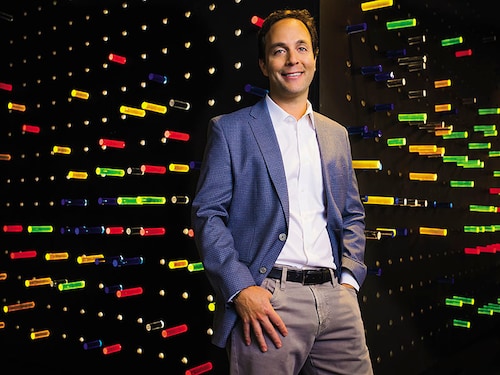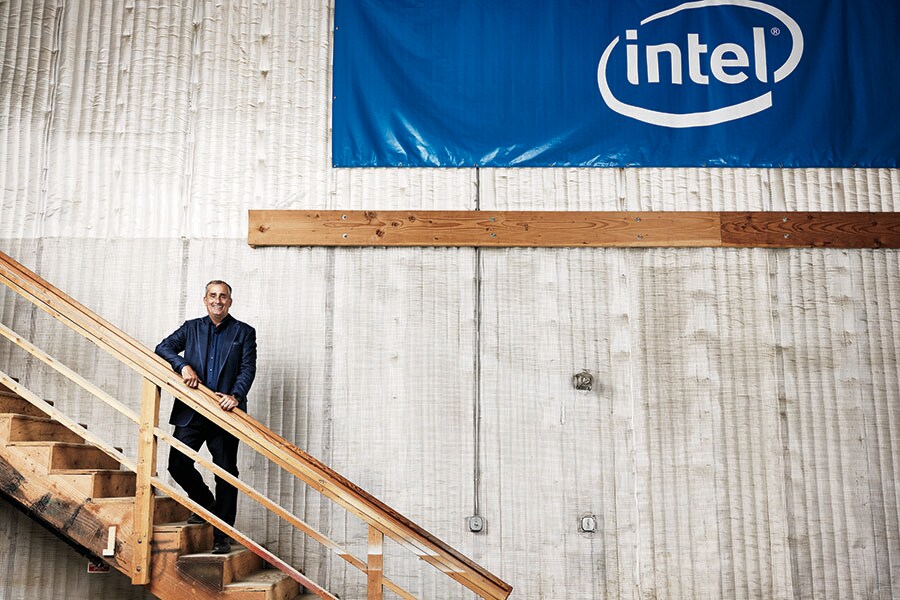The Just 100: Competition is the new union
American corporations have spent decades slashing jobs, cutting benefits and putting shareholders before employees. But guess what: The Just 100 companies that pay and treat their workers well outperf


 After worker feedback, Zillow’s Spencer Rascoff has increased sabbaticals and bereavement leave
After worker feedback, Zillow’s Spencer Rascoff has increased sabbaticals and bereavement leave
Image: Tim Pannell for Forbes
Almost two years ago, Intel CEO Brian Krzanich made the kind of headlines no company wants: In the process of restructuring the storied chipmaker, he was eliminating 11 percent of its workforce—12,000 jobs. But far more quietly, Krzanich was focusing on something seemingly contradictory: Cranking up a programme to prevent the workers the company wanted to keep from walking out the door.
The retention initiative was launched as part of a diversity push. In 2015, Krzanich had pledged some $60 million a year to boost underrepresented groups at Intel, yet in that year, the company treaded water: 584 African-Americans, Hispanics and Native Americans were hired, and 580 from those groups departed. Ed Zabasajja, a Ugandan-born, Auburn University-trained engineer who oversees internal diversity analytics, was keen to acquire data to figure out why employees left—before they did.
Thus was born WarmLine, whose touchy-feely name hasn’t prevented more than 10,000 workers from reaching out. More than just a data-collection operation, WarmLine quickly developed into a way to address problems such as finding colleagues for isolated workers to bond with, mediating management disputes, arranging transfers and even asking for raises. And it also became an outlet for the entire company—roughly half of WarmLine’s users have been white and Asian men.
“There’s a limited number of people who can do many of these technologies,” Krzanich says. His product, ultimately, relies on talent.
Zillow, the online real estate marketplace, has gone even further to keep its key employees. CEO Spencer Rascoff sees recruitment and retention as the company’s leading priority and has a new “internal mobility” team focussed on top performers. After one star recently decided during a six-week paid sabbatical (yep, Zillow grants one every six years) that he needed to leave and pursue a big change, Zillow kept in touch. Within two months, the defector was back in a new role. “It’s much more economical to just keep people motivated and engaged over a long period of time rather than churning and burning people,’’ Rascoff says.
Conventional wisdom holds that employees have less power than they’ve had in decades, with a growing share of jobs vulnerable to automation or offshoring and just 6.4 percent of US private-sector workers in unions. Exhibit A is the recovery from the Great Recession: As corporate profits set new records, median wages barely budged until last year. That anxiety is reflected in the Just 100, the first-ever ranking of companies based on what Americans expect of a good corporate citizen. Some 80 percent of the 72,000 Americans surveyed over the past three years by Just Capital say companies aren’t sharing enough of their success with employees. Asked to cite what a company’s top priority should be, 33 percent said workers or jobs, compared with just 6 percent who said shareholders or management. Intel CEO Brian Krzanich: “I’ve never been asked [by analysts], ‘How do you treat employees?’”
Intel CEO Brian Krzanich: “I’ve never been asked [by analysts], ‘How do you treat employees?’”
Image: Ethan Pines For Forbes Brian Krzanich Wears A Wool, Cashmere And Silk Sport Jacket ($5,200), Wool Trousers With Crocodile Trim ($1,300), Cotton Shirt ($850), And Crocodile Belt ($2,800) By Stefano Ricci.But a free labour market can cut both ways. With unemployment now scraping 4 percent, and traditional rewards of long tenure (pensions and protection from layoffs) just a memory, employees have little reason to be loyal. The “quit rate” for 2017 is likely to be the highest in over a decade, with 26 percent of workers voluntarily waving goodbye. So companies that fare well on the Just 100 list are attempting to rebuild workers’ loyalty, 21st-century-style: Not with no-layoff guarantees but with fair pay, bonuses, stock options, new benefits (think paid family leave, sabbaticals and student-loan repayments) and programmes designed to fulfill millennial demands for work-life balance, inclusive workplaces and professional growth. Competition is the new union. “Transparency combined with a tight labour market is effectively working as an advocate for employee betterment,” says Andrew Chamberlain, the chief economist at Glassdoor.
The new benefits are far more likely to be lavished on in-demand, highly skilled workers, and there are still too many terrible jobs and employers in America. But there’s an aspect to this phenomenon that might surprise some less enlightened CEOs and investors: Treating workers right ultimately benefits shareholders after all, and not only in tight labour markets. The companies of the Just 100 have returned three percentage points a year more than the S&P 500 over the last five years.
So does great performance allow companies to treat workers better, or does worker treatment drive great performance? While there’s some measure of both at work, the latter seems to be the main dynamic. In 2012, Alex Edmans, a finance professor at Penn’s Wharton School who is now at the London Business School, analysed 27 years of stock market returns for US companies chosen as top places to work. They outperformed the market by 2.3 to 3.8 points per year for the entire stretch, no matter the broader economic conditions. More recently, he studied the relationship between employee satisfaction and stock returns across 14 countries. In rigid labour markets, such as Germany’s, where regulations or union contracts provide a floor of benefits and limit management flexibility, spending extra on workers provides little in the way of return. But in flexible labour markets, such as in the US and the UK, treating workers better consistently produced higher returns.
The Just 100 get that, even if Wall Street doesn’t. Stock analysts “look at things like layoffs and they look at the cost. They don’t think about the employees’ long-term morale,” says Krzanich, of Intel, which claimed the No 1 spot this year on the Just 100. “I’ve never been asked, ‘How do you treat employees?’” Mark Costa, the CEO of Eastman Chemical, which ranks seventh on our list in terms of employee treatment, concurs: “Investors just want more dollars. I don’t think they spend a lot of time thinking about the consequences to the worker.”
The idea of treating workers well isn’t new—just erratic. In 1875, American Express became the first private employer to provide a retirement plan. By the early 1900s, when employee turnover often exceeded 100 percent a year, visionary businessmen were experimenting with new ways to attract and keep workers. Henry Ford introduced $5-a-day pay Milton Hershey and George Pullman built towns and housing for their workers a company called Norton Grinding pioneered paid vacations. The Great Depression halted, at least temporarily, this brand of welfare-minded capitalism.  The original example of welfare capitalism, Hershey and its CEO, Michele Buck, are upping their game to compete for talent
The original example of welfare capitalism, Hershey and its CEO, Michele Buck, are upping their game to compete for talent
Image: Jamel Toppin for Forbes
But then the government and unions stepped in. The National Labor Relations Act of 1935 guaranteed workers the right to organise and strike, and labour-union growth continued for the next three decades. Private pensions continued to grow during this time too—thanks in large part to the new labour unions. The unions’ decline began in the 1960s, when the Supreme Court issued a string of pro-employer rulings, holding, for example, that companies weren’t obligated to bargain over decisions “at the core of entrepreneurial control”. Reforms to the National Labor Relations Board under the Nixon Administration and anti-union Supreme Court decisions and executive actions during the Reagan years further weakened the union movement. In 1983, 16.8 percent of all private-sector workers were in a union, two-and-a-half times the rate of today.
Wall Street also played a role during this period. The Reagan era coincided with the Milken era, when leveraged buyouts were built around finding efficiencies, even if that meant treating company assets like Tinker Toys and workers as costs rather than assets. Barbarians at the Gate was a bestseller, the Predators’ Ball was the marquee event and the iconic 1987 movie Wall Street depicted workers as pawns of Armani-clad paper pushers. At the same time, companies began shifting from “defined benefit” retirement plans—a lifetime pension, with benefits backloaded to reward longer-tenured workers—to cheaper “defined contribution” plans. While this brought some sanity to corporate balance sheets, it also liberated workers to walk out the door with their retirement stash and roll it into an IRA or a new employer’s plan.
Those at the top of the Just 100 list figured out years ago that if every worker is now a free agent, a competitive advantage lies in bringing in and retaining the top talent.
Click here for The just 100 list
Take Delta, which ranks 60th on the list. After coming out of bankruptcy in 2007, the airline started giving a portion, now at least 10 percent, of its annual profits back to its workers. “We made a commitment to people that when things turned around and got better, they would see the first rewards from those initiatives,” says Delta CEO Ed Bastian. Plus, it gave every worker—including customer-service agents, who have to explain flight delays to cranky passengers—skin in the game. In the past five years, Delta has returned nearly $5 billion to employees—and 170 percent to its shareholders over the past decade, double the S&P 500. Not coincidentally, it’s also the least unionised workforce of any legacy airline.
If you want to see how to treat a worker in 2018, start at the top. That would be Nvidia, the No 1 Just 100 company in worker treatment. It competes with Apple, Google, Facebook and the rest of Silicon Valley’s giants for the best minds in technology. That means it pays well. But fair and competitive pay—the largest single driver of the Just 100—is taken almost as a given at top companies. Those motivated only by salary tend not to stay, no matter what. So to get stars, Nvidia treats them as stars, with universal employee perks that no union negotiation has ever extracted. New mothers get 22 weeks of fully paid leave. Workers get $6,000 of their students loans paid off every year, up to $30,000. Recently, Nvidia started offering to pay for in vitro fertilisation, adoption and, soon, egg freezing.
As a result, Nvidia says, its quit rate sits at 5 percent, roughly half that of its peers. It was the best-performing stock in the S&P 500 in 2016, giving its investors a 224 percent return. In 2017, through early December, it was up another 75 percent—four times the S&P’s gains.
Another key employee perk: Training. Accenture, No 6 on the Just 100, announced a $1.4 billion, four-year push to bolster current employees as the consultancy shifts to cloud and security services. In this labour market, simply hiring new experts with cutting-edge skills isn’t a viable approach for employers. And continual growth engages the kinds of employees worth keeping and promoting.
Companies looking to attract and keep younger workers, meanwhile (Read: Everyone), understand that millennials are looking for a better work-life balance than their parents had. At Zillow (No 51), the 42-year-old Rascoff leads by example: When he’s not travelling, he aims to get home by 5.30 and turns off his phone until 8.30 to spend time with his three kids, aged 6, 9 and 12.
Note that this explosion of family benefits has gone beyond the young tech companies. In 2016, Johnson & Johnson (No 35) increased fertility benefits from $25,000 to $35,000 and began reimbursing workers up to $20,000 for payments to surrogate mothers. “We’re also competing for talent as we bring in people from tech and other industries,” says Peter Fasolo, J&J’s chief human resources officer.
Click here for The just 100 list
Yet another new trend embraced by the old, established members of the Just 100: flexible benefits. At Procter & Gamble (No. 15), with 95,000 workers worldwide, every employee gets the equivalent of 1% to 2% of their salary set aside for a benefit of their choice, anything from disability insurance to financial planning to extra vacation time. Similarly, last year, 123-year-old Hershey (No 50) introduced a suite of “SmartFlex” policies for its white-collar workforce. Those include a number of leave options for new parents (they can take their time in one chunk or intermittently, as needed) and expanded opportunities to work from home or work flexible hours. And this attitude transcends what can be standardised or put into an employee manual. After Hurricane Maria hit Puerto Rico in September, Hershey spent $9,000 just to bring a new hire from there to New York and get her set up in an apartment.
How much has the world changed? Private equity firm KKR, Wall Street’s original “barbarians”, is adding goodies for the rank and file to its buyout formula. Since 2011, KKR has distributed more than $200 million in equity grants across four industrial deals to 10,000 blue-collar workers. “Companies can achieve incredible results when all employees are given the opportunity to think, act and participate as owners in the business,” says Pete Stavros, the leader of KKR’s industrials group. When KKR took industrial equipment maker Gardner Denver public in May, it gave 6,000 employees $100 million of stock grants—equal to 40 percent of a year’s pay for each. The company’s stock has urged 50 percent since the IPO, so each worker now holds stock worth 60 percent of his or her salary.
If competition now delivers what unions once did, it has also replaced government policy, or filled in where it’s lacking. The federal minimum wage hasn’t been increased since 2009, and at its current $7.25 an hour, it offers a path to poverty, with few avenues for advancement—a combination that explains why so many retail companies perform atrociously in the Just 100 rankings. That’s what made Target’s announcement in September interesting: The retailer said it was boosting its starting pay for all workers, including seasonal ones, to $11 an hour, and aiming to hit $15—the number favoured by “living wage” activists—by 2020. The announcement blathered on about paying workers fairly. A better reason: No one really needs to shop in a store right now. To avoid a race to the bottom, Target is making a bet, one pioneered by Costco, that its long-term fate is better aligned with superior consumer experience and a brand that people feel good about, rather than just lower prices or bigger dividends. “People expect it now,’’ says Hershey CEO Michele Buck. Consumers, especially younger ones, “want to know, ‘I’m buying a product from someone who cares about sourcing and who cares about the people who were involved in the product along the chain of production’.”
Of course, treating workers well sounds better as a profit strategy near full employment. What happens during the next downturn? Many companies will surely revert to their old habits—and pay the price that comes with short-term savings. “People will see through that company, and it’s not seen as genuine,” says Edmans, the finance professor. “The reason why you invest in your workers is because the business you want to build is one in which you believe workers should be treated fairly, not in response to market conditions.”
As the Just 100 reflects, the American public seems primed to reward those who act well. And the markets will follow. Eastman Chemical offers a case study from the financial crisis. Rather than major layoffs, management took an employee suggestion and cut wages by 5 percent across the board. “Everyone was aggressively cutting costs. We took a pay cut, from the board to frontline employees, and kept investing in innovation,” says CEO Costa. Full salaries were soon reinstated, and Eastman’s stock roared higher, returning three times as much as the S&P 500 since the market bottomed in 2009.
“Companies that don’t invest in talent management will be left behind,’’ predicts Zillow’s Rascoff. “This is not just HR gobbledygook, this is mission-critical work.” A mission that defines America’s new labour reality.
Click here for The just 100 list
First Published: Feb 10, 2018, 06:55
Subscribe Now